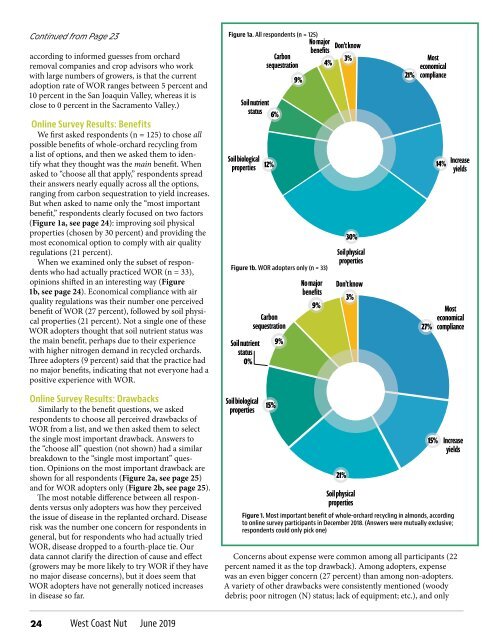West Coast Nut June 2019
You also want an ePaper? Increase the reach of your titles
YUMPU automatically turns print PDFs into web optimized ePapers that Google loves.
Continued from Page 23<br />
according to informed guesses from orchard<br />
removal companies and crop advisors who work<br />
with large numbers of growers, is that the current<br />
adoption rate of WOR ranges between 5 percent and<br />
10 percent in the San Joaquin Valley, whereas it is<br />
close to 0 percent in the Sacramento Valley.)<br />
Online Survey Results: Benefits<br />
We first asked respondents (n = 125) to chose all<br />
possible benefits of whole-orchard recycling from<br />
a list of options, and then we asked them to identify<br />
what they thought was the main benefit. When<br />
asked to “choose all that apply,” respondents spread<br />
their answers nearly equally across all the options,<br />
ranging from carbon sequestration to yield increases.<br />
But when asked to name only the “most important<br />
benefit,” respondents clearly focused on two factors<br />
(Figure 1a, see page 24): improving soil physical<br />
properties (chosen by 30 percent) and providing the<br />
most economical option to comply with air quality<br />
regulations (21 percent).<br />
When we examined only the subset of respondents<br />
who had actually practiced WOR (n = 33),<br />
opinions shifted in an interesting way (Figure<br />
1b, see page 24). Economical compliance with air<br />
quality regulations was their number one perceived<br />
benefit of WOR (27 percent), followed by soil physical<br />
properties (21 percent). Not a single one of these<br />
WOR adopters thought that soil nutrient status was<br />
the main benefit, perhaps due to their experience<br />
with higher nitrogen demand in recycled orchards.<br />
Three adopters (9 percent) said that the practice had<br />
no major benefits, indicating that not everyone had a<br />
positive experience with WOR.<br />
Figure 1a. All respondents (n = 125)<br />
Soil nutrient<br />
status<br />
Soil biological<br />
properties<br />
Carbon<br />
sequestration<br />
12%<br />
6%<br />
9%<br />
No major<br />
benefits<br />
4%<br />
Figure 1b. WOR adopters only (n = 33)<br />
Soil nutrient<br />
status<br />
0%<br />
Carbon<br />
sequestration<br />
9%<br />
No major<br />
benefits<br />
9%<br />
Don’t know<br />
3%<br />
30%<br />
Soil physical<br />
properties<br />
Don’t know<br />
3%<br />
21%<br />
Most<br />
economical<br />
compliance<br />
27%<br />
14%<br />
Increase<br />
yields<br />
Most<br />
economical<br />
compliance<br />
Online Survey Results: Drawbacks<br />
Similarly to the benefit questions, we asked<br />
respondents to choose all perceived drawbacks of<br />
WOR from a list, and we then asked them to select<br />
the single most important drawback. Answers to<br />
the “choose all” question (not shown) had a similar<br />
breakdown to the “single most important” question.<br />
Opinions on the most important drawback are<br />
shown for all respondents (Figure 2a, see page 25)<br />
and for WOR adopters only (Figure 2b, see page 25).<br />
The most notable difference between all respondents<br />
versus only adopters was how they perceived<br />
the issue of disease in the replanted orchard. Disease<br />
risk was the number one concern for respondents in<br />
general, but for respondents who had actually tried<br />
WOR, disease dropped to a fourth-place tie. Our<br />
data cannot clarify the direction of cause and effect<br />
(growers may be more likely to try WOR if they have<br />
no major disease concerns), but it does seem that<br />
WOR adopters have not generally noticed increases<br />
in disease so far.<br />
Soil biological<br />
properties<br />
15%<br />
21%<br />
Soil physical<br />
properties<br />
15%<br />
Increase<br />
yields<br />
Figure 1. Most important benefit of whole-orchard recycling in almonds, according<br />
to online survey participants in December 2018. (Answers were mutually exclusive;<br />
respondents could only pick one)<br />
Concerns about expense were common among all participants (22<br />
percent named it as the top drawback). Among adopters, expense<br />
was an even bigger concern (27 percent) than among non-adopters.<br />
A variety of other drawbacks were consistently mentioned (woody<br />
debris; poor nitrogen (N) status; lack of equipment; etc.), and only<br />
24<br />
<strong>West</strong> <strong>Coast</strong> <strong>Nut</strong> <strong>June</strong> <strong>2019</strong>


















